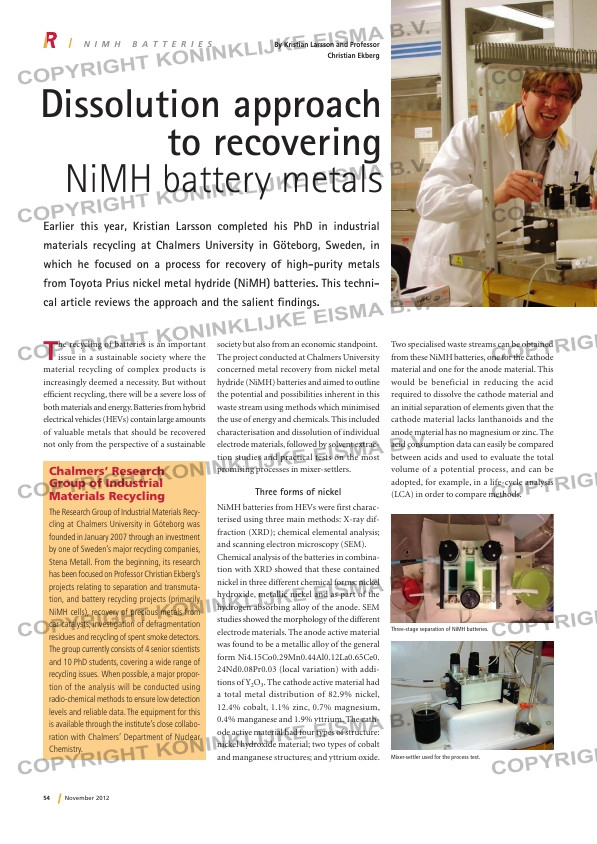Page 54 from: November 2012

54 November 2012
Dissolution approach
to recovering
NiMH battery metals
The recycling of batteries is an important issue in a sustainable society where the
material recycling of complex products is
increasingly deemed a necessity. But without
efficient recycling, there will be a severe loss of
both materials and energy. Batteries from hybrid
electrical vehicles (HEVs) contain large amounts
of valuable metals that should be recovered
not only from the perspective of a sustainable
society but also from an economic standpoint.
The project conducted at Chalmers University
concerned metal recovery from nickel metal
hydride (NiMH) batteries and aimed to outline
the potential and possibilities inherent in this
waste stream using methods which minimised
the use of energy and chemicals. This included
characterisation and dissolution of individual
electrode materials, followed by solvent extrac-
tion studies and practical tests on the most
promising processes in mixer-settlers.
Three forms of nickel
NiMH batteries from HEVs were first charac-
terised using three main methods: X-ray dif-
fraction (XRD); chemical elemental analysis;
and scanning electron microscopy (SEM).
Chemical analysis of the batteries in combina-
tion with XRD showed that these contained
nickel in three different chemical forms: nickel
hydroxide, metallic nickel and as part of the
hydrogen absorbing alloy of the anode. SEM
studies showed the morphology of the different
electrode materials. The anode active material
was found to be a metallic alloy of the general
form Ni4.15Co0.29Mn0.44Al0.12La0.65Ce0.
24Nd0.08Pr0.03 (local variation) with addi-
tions of Y2O3. The cathode active material had
a total metal distribution of 82.9% nickel,
12.4% cobalt, 1.1% zinc, 0.7% magnesium,
0.4% manganese and 1.9% yttrium. The cath-
ode active material had four types of structure:
nickel hydroxide material; two types of cobalt
and manganese structures; and yttrium oxide.
Two specialised waste streams can be obtained
from these NiMH batteries, one for the cathode
material and one for the anode material. This
would be beneficial in reducing the acid
required to dissolve the cathode material and
an initial separation of elements given that the
cathode material lacks lanthanoids and the
anode material has no magnesium or zinc. The
acid consumption data can easily be compared
between acids and used to evaluate the total
volume of a potential process, and can be
adopted, for example, in a life-cycle analysis
(LCA) in order to compare methods.
N I M H B A T T E R I E S By Kristian Larsson and Professor
Christian Ekberg
Chalmers’ Research
Group of Industrial
Materials Recycling
The Research Group of Industrial Materials Recy-
cling at Chalmers University in Göteborg was
founded in January 2007 through an investment
by one of Sweden’s major recycling companies,
Stena Metall. From the beginning, its research
has been focused on Professor Christian Ekberg’s
projects relating to separation and transmuta-
tion, and battery recycling projects (primarily
NiMH cells), recovery of precious metals from
car catalysts, investigation of defragmentation
residues and recycling of spent smoke detectors.
The group currently consists of 4 senior scientists
and 10 PhD students, covering a wide range of
recycling issues. When possible, a major propor-
tion of the analysis will be conducted using
radio-chemical methods to ensure low detection
levels and reliable data. The equipment for this
is available through the institute’s close collabo-
ration with Chalmers’ Department of Nuclear
Chemistry.
Earlier this year, Kristian Larsson completed his PhD in industrial
materials recycling at Chalmers University in Göteborg, Sweden, in
which he focused on a process for recovery of high-purity metals
from Toyota Prius nickel metal hydride (NiMH) batteries. This techni-
cal article reviews the approach and the salient findings.
Three-stage separation of NiMH batteries.
Mixer-settler used for the process test.
RI-9_NiMHbatteries.indd 54 09-11-12 15:35



